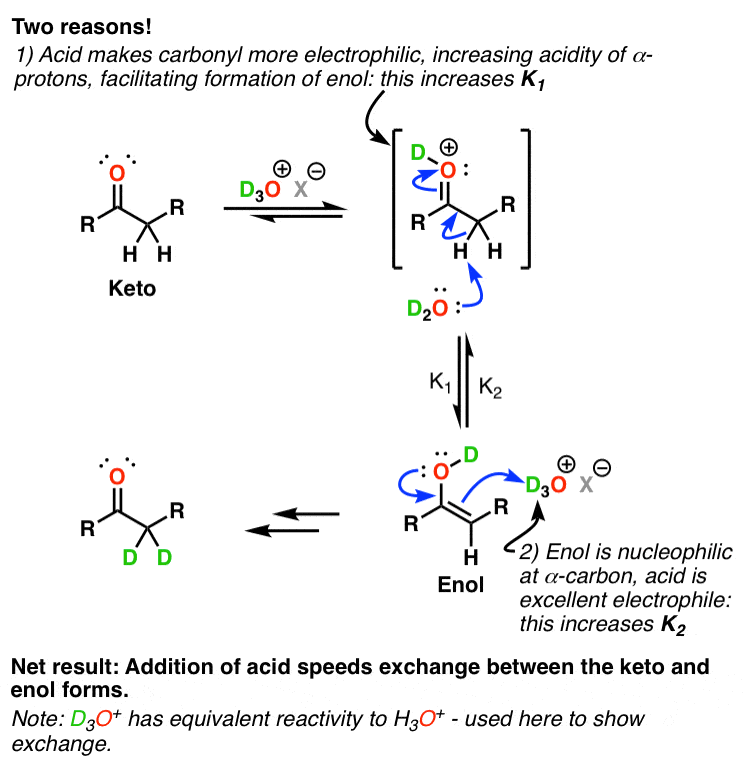
The enol form of acetone, after treatment with
(A)-

(B)-

(C)-

(D)-





Answer
492.3k+ views
Hint: The acetone is present in two isomeric forms, which are favoured by the catalyses with an acid or base. The addition of acid causes the interconversion between the two forms to take place with ease.
Complete step by step answer:
The ketone has two isomeric forms which are called tautomers, having the same carbon structure but differ in their position of protons and electrons. It is the keto- form and the enol- form involving the intramolecular proton transfer.

When the ketone is dissolved in the acid which acts as catalyst, the rate of incorporation of deuterium increases in both the forward and reverse direction. As it lowers the barrier between the interconversion.
Let the forward reaction rate (keto to enol) be
- In the keto to enol conversion, carbonyl carbon becomes more electrophilic by the addition of deuterium to the carbonyl by acid. Then, the carbon adjacent to the carbonyl group, that is, the
- In the enol to the keto form conversion, the

Therefore, addition to excess acid to acetone, all the
So, the correct answer is “Option D”.
Note: The keto-enol tautomerization is catalysed by the presence of an acid or base. Under normal condition, the keto-form is more stable and favoured in the ratio
Also, the keto-enol tautomerization under normal condition is favourable, in case of aldehyde and ketone, but not so, in ester, amides and carboxylic acid.
Complete step by step answer:
The ketone has two isomeric forms which are called tautomers, having the same carbon structure but differ in their position of protons and electrons. It is the keto- form and the enol- form involving the intramolecular proton transfer.

When the ketone is dissolved in the acid which acts as catalyst, the rate of incorporation of deuterium increases in both the forward and reverse direction. As it lowers the barrier between the interconversion.
Let the forward reaction rate (keto to enol) be
- In the keto to enol conversion, carbonyl carbon becomes more electrophilic by the addition of deuterium to the carbonyl by acid. Then, the carbon adjacent to the carbonyl group, that is, the
- In the enol to the keto form conversion, the

Therefore, addition to excess acid to acetone, all the
So, the correct answer is “Option D”.
Note: The keto-enol tautomerization is catalysed by the presence of an acid or base. Under normal condition, the keto-form is more stable and favoured in the ratio
Also, the keto-enol tautomerization under normal condition is favourable, in case of aldehyde and ketone, but not so, in ester, amides and carboxylic acid.
Recently Updated Pages
Express the following as a fraction and simplify a class 7 maths CBSE

The length and width of a rectangle are in ratio of class 7 maths CBSE

The ratio of the income to the expenditure of a family class 7 maths CBSE

How do you write 025 million in scientific notatio class 7 maths CBSE

How do you convert 295 meters per second to kilometers class 7 maths CBSE

Write the following in Roman numerals 25819 class 7 maths CBSE

Trending doubts
Give 10 examples of unisexual and bisexual flowers

Draw a labelled sketch of the human eye class 12 physics CBSE

Franz thinks Will they make them sing in German even class 12 english CBSE

Draw a diagram of a flower and name the parts class 12 biology ICSE

What is the Full Form of PVC, PET, HDPE, LDPE, PP and PS ?

The speed of light will be minimum while passing through class 12 physics CBSE




